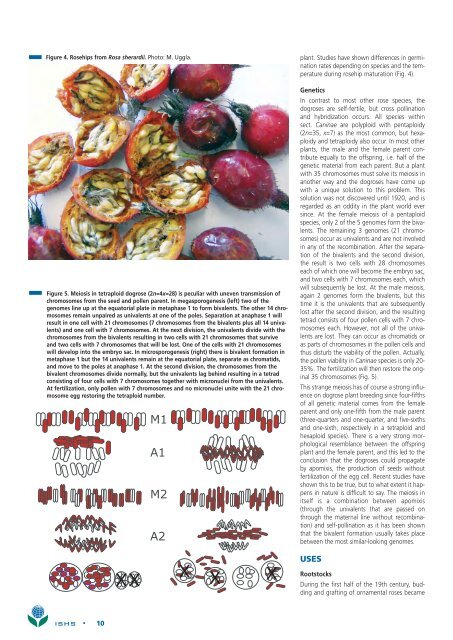Chronica Horticulturae volume 49 number 2 ... - Acta Horticulturae
Chronica Horticulturae volume 49 number 2 ... - Acta Horticulturae
Chronica Horticulturae volume 49 number 2 ... - Acta Horticulturae
You also want an ePaper? Increase the reach of your titles
YUMPU automatically turns print PDFs into web optimized ePapers that Google loves.
Figure 4. Rosehips from Rosa sherardii. Photo: M. Uggla.<br />
Figure 5. Meiosis in tetraploid dogrose (2n=4x=28) is peculiar with uneven transmission of<br />
chromosomes from the seed and pollen parent. In megasporogenesis (left) two of the<br />
genomes line up at the equatorial plate in metaphase 1 to form bivalents. The other 14 chromosomes<br />
remain unpaired as univalents at one of the poles. Separation at anaphase 1 will<br />
result in one cell with 21 chromosomes (7 chromosomes from the bivalents plus all 14 univalents)<br />
and one cell with 7 chromosomes. At the next division, the univalents divide with the<br />
chromosomes from the bivalents resulting in two cells with 21 chromosomes that survive<br />
and two cells with 7 chromosomes that will be lost. One of the cells with 21 chromosomes<br />
will develop into the embryo sac. In microsporogenesis (right) there is bivalent formation in<br />
metaphase 1 but the 14 univalents remain at the equatorial plate, separate as chromatids,<br />
and move to the poles at anaphase 1. At the second division, the chromosomes from the<br />
bivalent chromosomes divide normally, but the univalents lag behind resulting in a tetrad<br />
consisting of four cells with 7 chromosomes together with micronuclei from the univalents.<br />
At fertilization, only pollen with 7 chromosomes and no micronuclei unite with the 21 chromosome<br />
egg restoring the tetraploid <strong>number</strong>.<br />
M1<br />
A1<br />
M2<br />
A2<br />
plant. Studies have shown differences in germination<br />
rates depending on species and the temperature<br />
during rosehip maturation (Fig. 4).<br />
Genetics<br />
In contrast to most other rose species, the<br />
dogroses are self-fertile, but cross pollination<br />
and hybridization occurs. All species within<br />
sect. Caninae are polyploid with pentaploidy<br />
(2n=35, x=7) as the most common, but hexaploidy<br />
and tetraploidy also occur. In most other<br />
plants, the male and the female parent contribute<br />
equally to the offspring, i.e. half of the<br />
genetic material from each parent. But a plant<br />
with 35 chromosomes must solve its meiosis in<br />
another way and the dogroses have come up<br />
with a unique solution to this problem. This<br />
solution was not discovered until 1920, and is<br />
regarded as an oddity in the plant world ever<br />
since. At the female meiosis of a pentaploid<br />
species, only 2 of the 5 genomes form the bivalents.<br />
The remaining 3 genomes (21 chromosomes)<br />
occur as univalents and are not involved<br />
in any of the recombination. After the separation<br />
of the bivalents and the second division,<br />
the result is two cells with 28 chromosomes<br />
each of which one will become the embryo sac,<br />
and two cells with 7 chromosomes each, which<br />
will subsequently be lost. At the male meiosis,<br />
again 2 genomes form the bivalents, but this<br />
time it is the univalents that are subsequently<br />
lost after the second division, and the resulting<br />
tetrad consists of four pollen cells with 7 chromosomes<br />
each. However, not all of the univalents<br />
are lost. They can occur as chromatids or<br />
as parts of chromosomes in the pollen cells and<br />
thus disturb the viability of the pollen. Actually,<br />
the pollen viability in Caninae species is only 20-<br />
35%. The fertilization will then restore the original<br />
35 chromosomes (Fig. 5).<br />
This strange meiosis has of course a strong influence<br />
on dogrose plant breeding since four-fifths<br />
of all genetic material comes from the female<br />
parent and only one-fifth from the male parent<br />
(three-quarters and one-quarter, and five-sixths<br />
and one-sixth, respectively in a tetraploid and<br />
hexaploid species). There is a very strong morphological<br />
resemblance between the offspring<br />
plant and the female parent, and this led to the<br />
conclusion that the dogroses could propagate<br />
by apomixis, the production of seeds without<br />
fertilization of the egg cell. Recent studies have<br />
shown this to be true, but to what extent it happens<br />
in nature is difficult to say. The meiosis in<br />
itself is a combination between apomixis<br />
(through the univalents that are passed on<br />
through the maternal line without recombination)<br />
and self-pollination as it has been shown<br />
that the bivalent formation usually takes place<br />
between the most similar-looking genomes.<br />
XX<br />
X X<br />
X<br />
USES<br />
Rootstocks<br />
During the first half of the 19th century, budding<br />
and grafting of ornamental roses became<br />
ISHS • 10
















